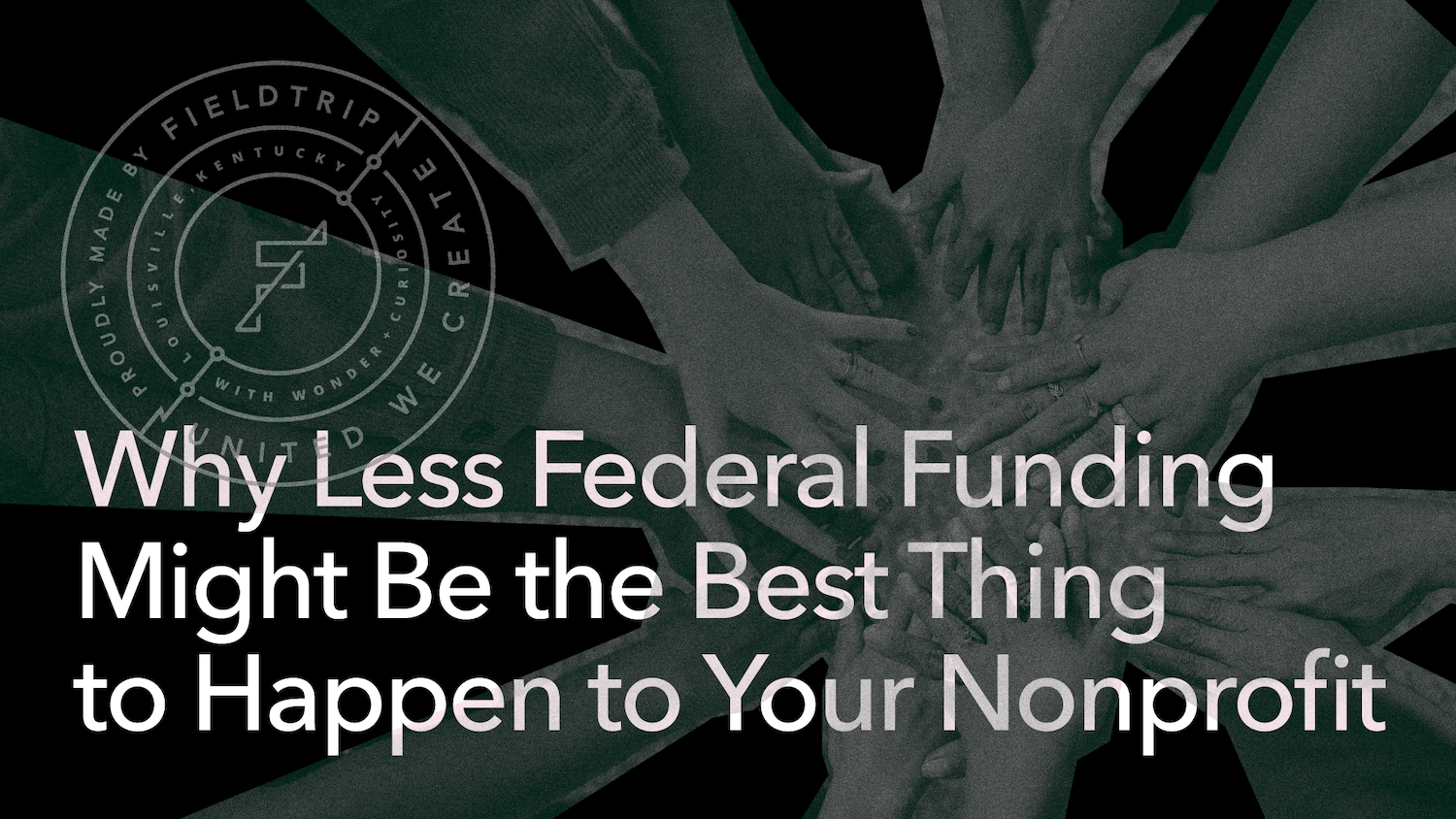Hi, I’m Jane Pfeiffer with Fieldtrip. Fieldtrip is on a mission to help nonprofits multiply their mission by reducing the friction and the cost of lost opportunities because people don’t know who they are or understand what they do or see the benefit of solving important social issues and how it impacts their world and makes the world better. So for the next few weeks in the Mission Multiplier series, we’re going to talk about some of the biggest pain points that impact nonprofit leaders and how there is an antidote to each one of them. What that looks like and how it can create some not only relief in making the communications and marketing work more efficient, but also increase effectiveness by doubling down on the impact and knowing where to focus and what to do first and when.
The nonprofit business model is under incredible pressure, the relevance for what you do is increasing. The need is increasing, but the friction around resources, people, time, money, everything is just becoming more difficult. What used to work is no longer working. And so purpose driven organizations have to find a way to operate in a new way to operate, to deliver different results. You know, the definition of insanity. Do the same thing over and over again and expect a different result. Well, we can’t just hope it gets better. We have to make it happen. The friction around time and the things that we do, being stuck in the business rather than on the business, there’s so many challenges that are facing us every day. We have to look to find new and different ways. What’s often missed is the simplicity of some changes that can be made that can have incredible differences, and shifting towards new beliefs around marketing and communications in our habits and what we pay attention to can reduce these costs of lost opportunities, connect and nurture audiences, and multiply the sustainability in the impact of your mission.
Today we’re going to return to that pain point that I’ve mentioned before. The relevancy and the need for your mission is increasing at a rapid rate, but the friction around what you do, the time, resources and financials that you need to perform the mission are also increasing at an exponential rate. It’s a mathematical formula that just won’t play out. It’s not going to resolve itself. So how do we do things differently? The antidote for today is to focus on one audience. As communicators and marketers in the organization, we think about all the different people that we need to influence. Community partners, sponsors, individual donors, our clients, our employees, legislators. The list goes on and on and on. That’s a lot of people. What we end up doing is taking a single piece of communication, let’s call it the email newsletter, and create one version and send it out to everyone and hope for the best.
We can make our jobs easier by focusing on and prioritizing one audience and by knowing and understanding that audience, everyone else will come along. That one audience is most often our beneficiaries. Now, this isn’t always the case, and we’re going to talk about that a little later. But the vast majority of the time, the most important audience are the people that we serve. By focusing on them, telling about the world through their eyes, their perspectives, and when our website meet and greets them where they are and how our organization can help them, how we recognize their need, we know the hurdles that are in their way, we are convincing others that we’re an expert in our field, that we understand the needs, priorities and obstacles of our beneficiaries or clients or patients that that’s who we talk to. We focus on them and others don’t go away because we’re not talking to them. They will actually invest more in us because of the belief that we’re authentic and knowledgeable and they see it. It’s evidence that we are doing and living the mission in everything in our communication and everything that we produce.
So they believe and come along as a result of that. The impact is that your organization is seen as a solution because you’re working on solving a problem as opposed to just another provider in probably a crowded sector that is asking for money, asking for volunteers, asking for support, asking to change opinions.
Here’s how you know when the beneficiary is your audience and when it might not be. We are going to talk about a fictitious nonprofit that helps create financial equity through homeownership and all the services and support that is required to do that. When we look beyond the organizational level and we look at the department or the program level, we see five different service lines. First is real estate development. Knowing how and where to secure property, what can be developed, what’s going to have challenges, where selling opportunities are going to be great and where the need is the greatest. So that’s the first division. The second is consulting with other nonprofits or community entities on how to create affordable housing within their neighborhoods. Third is multifamily housing, the physical building of multifamily units to create quality, safe and secure housing at a price that is affordable and in a model that is sustainable and safe and scalable. The fourth is specialty housing for senior citizens or for disabled or other special situations that might not be able to use the traditional apartment style living in a multifamily unit. Last but not least, is what would probably be the smallest division, is the home ownership in this organization. These other departments and programs exist in order to make the last division possible. If you were to remove that last program, it’s really an affordable housing nonprofit and there are plenty of them out there. But it’s the connection to making home ownership available through the scale of which they operate. That’s what makes this organization more unique than others.
Now, let’s take this to the functional level. Under real estate development, this allows the organization to take on risk, to scale, to convene people around incentives that might be needed for this real estate development fund. And it funds the vision in consulting. It’s how to replicate because there’s such a dire need for affordable housing so that no organization can create a hold on it. We need everybody to think about how to solve this problem. And then within multifamily housing, the function is again housing stability and safety. Under specialty. It’s the same, you know, benefits. And then under home ownership, the things that they have to deliver is, well, one, the housing units, the stock, the financial health down payment assistance, equity, stability and safety. So that’s the functional level.
Then we go to the audience level. On real estate development, you know, it’s a very niche audience. Banks, legislators, policymakers, council members within the city, nonprofits are the audience for consulting potential and current residents are the audience for the units themselves. Finally, the potential homeowner is the audience for the last division. Again, if we were to look at this through staff members, through volume in terms of transactions or revenue and expenses, this last service line would be at the bottom of the list. But from a marketing and communications standpoint, this is where we prioritize because by prioritizing this, all the other audiences, including those who live in the apartments, those other nonprofits, the council member believe in what the organization is committed to see what makes them different, and knows what the support is ultimately resulting in.
So that’s the one audience that we prioritize on the website in the advertising. When it comes down to your email newsletter, it should be the entry and headline article, something directed to potential homeowners and then support it with additional content for your other audiences. Now let’s go back to how this program works. Prioritize one audience, do the org chart if you need to figure out which one that is, demonstrate your knowledge expertise by prioritizing and communicating with and for that audience. As a result, other audiences come along with you because they see you as a solution. Now, in the rare case that this doesn’t make sense to you, then there are exceptions, the exceptions being that your beneficiary does not opt in or approach you for services. For example, your beneficiary might be children or it might be people leaving incarceration. There is no choice that’s made by the beneficiary to come to you or to seek services. It’s made by someone else. So in that case, we would do the same exercise, but look for the key audience that all of the others will support in a different way than the way they want to support those who have suffered from child abuse or some of those other exceptions. We’ll walk through that again. It’s still important, though, that you demonstrate your expertise and knowledge. Donors are rarely the one audience. But again, we’re looking for that position as a solution.
Let’s take a look at one of those exceptions. OCAS. Oregon Child Abuse Solutions. This is a Fieldtrip client and they worked in the state of Oregon to help prevent and heal from child abuse. And working with the organization, we outlined three programs or service areas. The first is intervention. The function with intervention is to train first responders. So audiences would include a child welfare agents, law enforcement and health care clinicians. The second vertical is healing, helping the children and adults who are victims of abuse heal from their mental and physical harm. So that trauma informed cognitive behavioral therapy is the service and audience might be adult victims and child advocacy centers. They coordinate and communicate with over 20 centers throughout the state. Their primary audience are those centers, because that’s where the services are performed and where individuals would be welcomed for that healing effort. And then finally, prevention. The function is prevention, education and advocacy. So by “advocacy” here we mean on the legislative and policymaking level and education for community adults, mandatory reporters like teachers and coaches and, of course, policy makers. So when you look at these three, nowhere is the beneficial theory, the primary audience that we should communicate to. But by looking at the prevention, when we communicate to the community about the importance of understanding child abuse, the ownership that we all have a role to play in the acceptance that it is not something that can be dismissed and put over there because that doesn’t happen in my family, my school, my community, my church. That’s a win. And the other audiences that support intervention and healing will believe in the power of OCAS. So therefore, that prevention is our primary communication channel, focusing on community adults and mandatory reporters, that’s who the organization speaks to day in and day out, through their email newsletter, their websites, their trainings, and other forms of communication. There are lists of people to target for the intervention and for the healing space. Well, I hate to say it, but there are also, kind of a workflow process from where there has been intervention. So those people have, to some extent, been identified. It’s the marketing communications focus to prioritize the one audience that can make the most difference and that others will believe in and that lives over in prevention.
So thank you for listening and to see more Mission Multiplier videos, feel free to visit wearefieldtrip.com/nonprofits.

